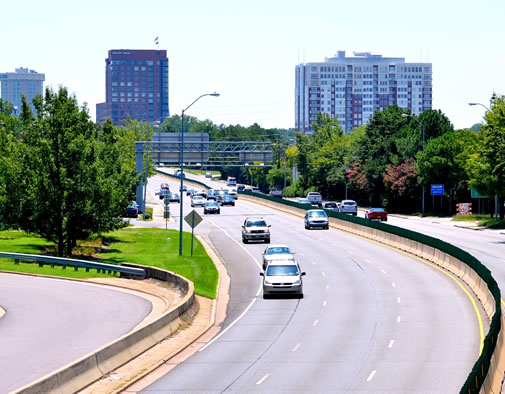A new vision for Capital Boulevard, the northern gateway into downtown Raleigh, will be getting a facelift during the next decade under a plan out for review from the city.
The City of Raleigh Capital Boulevard Corridor Study completed this month proposes new recommendations and visions that not only include improvements to the existing corridor but also access for multi-modal transportation and green infrastructure.
This study has been in the works for about three years, and the city is accepting public comments now through April 12. The City Council will review the recommendations in May and will then determine further engineering and design studies.
Learn more about the study and submit comments.
Ken Bowers, the city’s deputy planning director, said the response from the public thus far has been positive, but the city wants to hear feedback from residents on any changes as well as anything they may not like.
The completion in total will cost about $60 million. Bowers hopes to complete most of the recommendations within 15 years, with major progress in five.
“I think of them as clusters of related projects that ought to happen together in order for individual projects to remain successful,” Bowers said.
Alan Wiggs, member of the Bicycle and Pedestrian Advisory Commission, said these projects will make Capital Boulevard a nicer entrance to the city.
“The whole aspect that Capital Boulevard’s always been a barrier between northwest and southeast, the way it cuts through the city, it kind of cuts a lot of stuff off,” he said.

City of Raleigh Deputy Planning Director Ken Bowers speaks at the Capital Boulevard Corridor Study Workshop, Thursday 24 June 2010, held at Bobby Murray Chevrolet. Photo by h0tgrits/Flickr Creative Commons.
Bobby Poole, a long-time resident of the area who retired from the State Property Office after 30 years, said he has been an unofficial consultant on the project.
“The corridor itself, portions of it had become blighted,” Poole said. “It’s a major gateway into the City of Raleigh and it needed a face lift.”
According to Bowers, the opening vision for changes to the corridor was how to make it a better highway; the average traffic is 60,000 trips per day. Then planners looked at how to improve transit service, which became a segue for the green infrastructure component.
Parts of the corridor don’t even have sidewalks. This new plan includes changes to make it more oriented to multiple forms of transportation, including pedestrians, cyclists, cars and buses, and the potential for light rail later down the road.
And those “finer details” of the traffic pattern will help the gateway, Wiggs said.
“It’ll definitely open up to multi-modal transportation, especially where they have the light rail stations picked out,” Wiggs said. “Hopefully, they’ll go with that particular layout as part of the redesign.”
The corridor also includes changes to highway ramps built in 1958 and 1962. Bowers said most of the ramps in the study area are well used, but the ramps to Fairview Road, opened in 1962, only carry an average of 2,200 vehicles daily — about what a local street would carry.
Once the two bridges on Wade Avenue over Capital Boulevard and Capital Boulevard over Peace Street are replaced by 2016, Bowers said the city can start looking at park improvements there and find out what the community wants.
“There’s a lot of planning to be done on it, and that’s going to be a very exciting project to kind of feel out what our vision is for that space,” he said.
The green infrastructure component of the study includes two target areas, one at the North Boulevard Park and one at the city-owned land at Devereux Meadows, across Capital Boulevard from the old Seaboard Railroad Bridge.

Photo by City of Raleigh.
“This is the first realistic proposal for how to get a greenway connection from Crabtree Creek to downtown,” Bowers said.
The plan recommends a connection between the two linear greenway open spaces in the northern and southern ends of the study area, which would create room for multi-modal transportation.
“We think providing this multi-modal connection … to Peace Street is a much better way to go,” Bowers said. “The current infrastructure is expensive but has no room for other modes.”

Capital Boulevard Peace Street Bridge. Photo by Leo Suarez.
Bowers said the improvements at North Boulevard are critical.
“We had identified problems with repeated flooding, and there’s a terrible water quality issue,” he said.
Poole said there have also been issues of criminal activity near North Boulevard and that area needs some major improvements, which could in turn benefit the city and the neighborhoods in that area.
For all those reasons, Poole said it is past time to make these changes.
“It’s a large project but hopefully high enough on the city’s priority list,” Poole said.
